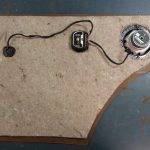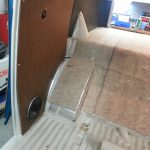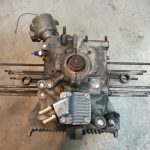Since the rebuild I’ve had trouble getting the bus to do 65 for more than about 5 miles without getting into the danger zone of overheating. I’ve looked at various things in the process of debugging this but tonight I think I finally found the problem; and it’s related to the way that the ignition timing works…
(Begin technical rant, or just skip to the picture at the end) To adequately explain the problem I first have to explain that in an internal combustion engine the spark is timed so that the explosion in the cylinder is peaking just as the piston is beginning to move down; the explosion pushes the piston down, which ultimately moves the bus. However, the explosion is a chemical reaction, and it takes roughly the same amount of time to occur regardless of how fast the piston is moving; so when the piston starts to move faster (higher RPM) you have to start the explosion sooner to keep the explosion peak at the same place in the cycle. This moving of the spark event is called ‘advance’ and it’s accomplished with a very clever spring and counterweight mechanism inside the distributor, as the engine goes faster the counterweights fling outwards, moving the spark trigger (points) and advancing the timing. Additionally, because higher quantities of fuel take longer to burn, the timing also has to be advanced in proportion to load. This is accomplished by a vacuum canister on the distributor that’s connected to the carburetor, the more air/fuel that rush through the carburetor, the more vacuum is drawn on this canister, moving a push-rod that further advances the timing. I found that the canister on the bus’s distributor had ruptured, causing not only the advance to be too low, but also a vacuum leak (which is also bad for other reasons I won’t get into).
So what it boils down it is that at high RPM under load there is not enough advance due to the ruptured canister, the explosions are happening too late, which means that they’re not as effective, which means that all the explosions have to therefor be more powerful to achieve the same level of power, which means more fuel, which means more heat; and thus the overheating problem. I have a replacement vacuum canister on order which should not only solve the overheating problem but increase MPGs substantially. If you made it through all of that, here’s a picture of the bus from tonight while I was figuring all this out…





















